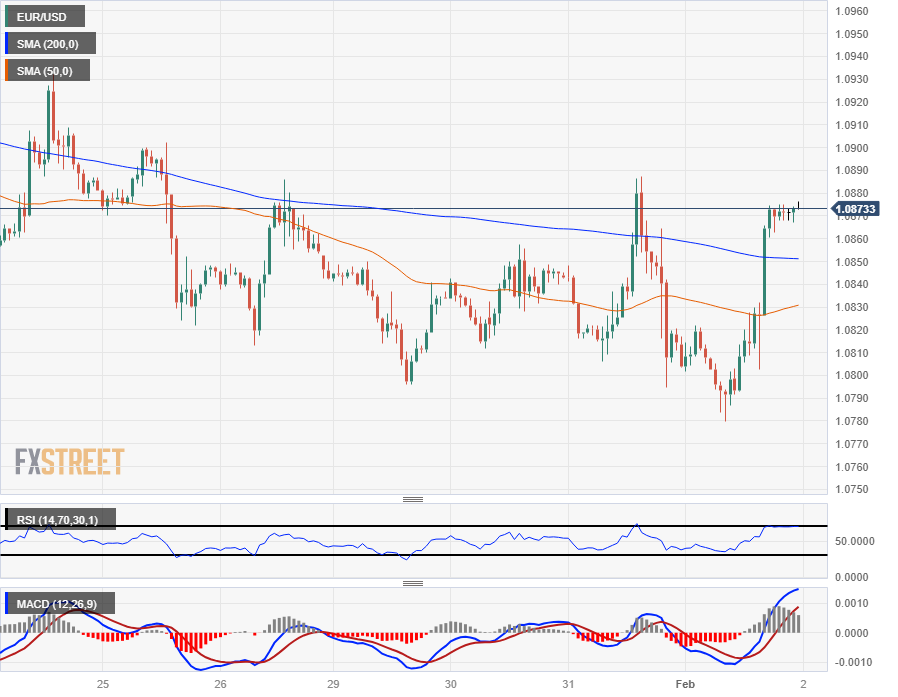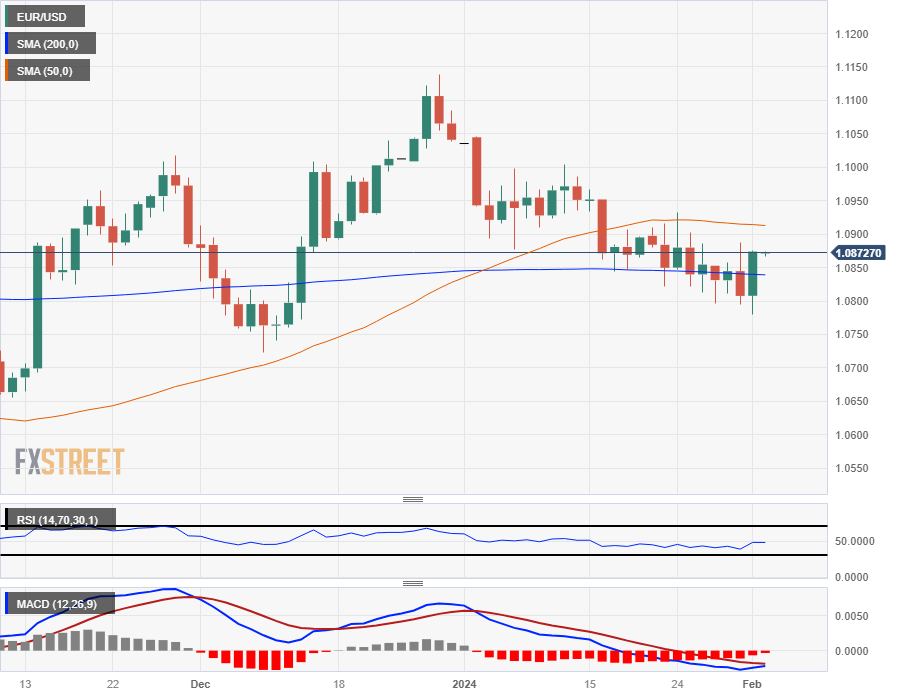EUR/USD recovers in choppy trading as markets lean into NFP prep
- EUR/USD sees choppy declines as 1.0900 slips away.
- European inflation vexes rate cut hopes.
- Markets pivot toward Friday’s US NFP.
EUR/USD dipped and recovered in a rough Thursday session, grinding lower in whipsaw action as the pair tests new lows in the near-term and slips further back from key technical levels.
European inflation declined less than markets were hoping, but currency markets have shifted into shorting the US Dollar (USD) across the board as investors recover from Wednesday’s hawkish showing from the US Federal Reserve (Fed).
Investors will be looking toward Friday’s US Nonfarm Payrolls (NFP) print for signs that the US economy will start to decay enough to force the Fed into a faster pace of rate cuts.
Daily digest market movers: EUR/USD recovers into near-term highs, but ceiling noticeable
- EUR/USD recovered back into 1.0880 region, but 1.0900 looks difficult to snag.
- The euro area saw inflation decline less than markets hoped for, keeping rate cut expectations at bay.
- Pan-European Harmonized Index of Consumer Prices (HICP) inflation eased to 3.3% for the year ended in January, missing the median market forecast of 3.2% and trimming only slightly back from the previous period’s 3.4%.
- US January ISM Manufacturing Purchasing Managers’ Index (PMI) bounded into a new three-plus year high of 49.1 versus the forecast backtick to 47.0 from December’s 47.1.
- US Initial Jobless Claims ticked upwards to 224K for the week ended January 26 versus the forecast 212K, rising above the previous week’s 215K (revised from 214K).
- EUR/USD set to continue a rough pattern heading into Friday’s US NFP, forecast to print at 180K for January versus December’s 216K.
- NFP Preview: Forecasts from 10 major banks
Euro price this week
The table below shows the percentage change of Euro (EUR) against listed major currencies this week. Euro was the strongest against the Australian Dollar.
| USD | EUR | GBP | CAD | AUD | JPY | NZD | CHF | |
| USD | -0.28% | -0.40% | -0.50% | 0.06% | -1.14% | -0.70% | -0.77% | |
| EUR | 0.28% | -0.10% | -0.20% | 0.36% | -0.82% | -0.57% | -0.48% | |
| GBP | 0.38% | 0.09% | -0.12% | 0.47% | -0.73% | -0.48% | -0.39% | |
| CAD | 0.51% | 0.21% | 0.11% | 0.57% | -0.62% | -0.35% | -0.26% | |
| AUD | -0.06% | -0.36% | -0.49% | -0.57% | -1.27% | -0.93% | -0.84% | |
| JPY | 1.13% | 0.82% | 0.91% | 0.60% | 1.18% | 0.24% | 0.35% | |
| NZD | 0.86% | 0.58% | 0.39% | 0.36% | 0.92% | -0.40% | 0.10% | |
| CHF | 0.77% | 0.47% | 0.38% | 0.28% | 0.83% | -0.35% | -0.09% |
The heat map shows percentage changes of major currencies against each other. The base currency is picked from the left column, while the quote currency is picked from the top row. For example, if you pick the Euro from the left column and move along the horizontal line to the Japanese Yen, the percentage change displayed in the box will represent EUR (base)/JPY (quote).
Technical analysis: EUR/USD bounces, but swing highs remain capped below 1.0900
EUR/USD climbed back over the 200-hour Simple Moving Average (SMA) newar 1.0850 on Thursday, but failed to reclaim near-term highs around 1.0880 as technical swings remain trapped in a lower highs pattern.
Thursday’s upswing brings EUR/USD back over the 200-day SMA just below the 1.0850 level, and the pair remains trapped in a roughly-bearish sideways grind, keeping EUR/USD trapped on the low side of technical consolidation range between the 50-day and 200-day SMAs with the ceiling priced in just above the 1.0900 handle.
EUR/USD hourly chart
EUR/USD daily chart
Euro FAQs
What is the Euro?
The Euro is the currency for the 20 European Union countries that belong to the Eurozone. It is the second most heavily traded currency in the world behind the US Dollar. In 2022, it accounted for 31% of all foreign exchange transactions, with an average daily turnover of over $2.2 trillion a day.
EUR/USD is the most heavily traded currency pair in the world, accounting for an estimated 30% off all transactions, followed by EUR/JPY (4%), EUR/GBP (3%) and EUR/AUD (2%).
What is the ECB and how does it impact the Euro?
The European Central Bank (ECB) in Frankfurt, Germany, is the reserve bank for the Eurozone. The ECB sets interest rates and manages monetary policy.
The ECB’s primary mandate is to maintain price stability, which means either controlling inflation or stimulating growth. Its primary tool is the raising or lowering of interest rates. Relatively high interest rates – or the expectation of higher rates – will usually benefit the Euro and vice versa.
The ECB Governing Council makes monetary policy decisions at meetings held eight times a year. Decisions are made by heads of the Eurozone national banks and six permanent members, including the President of the ECB, Christine Lagarde.
How does inflation data impact the value of the Euro?
Eurozone inflation data, measured by the Harmonized Index of Consumer Prices (HICP), is an important econometric for the Euro. If inflation rises more than expected, especially if above the ECB’s 2% target, it obliges the ECB to raise interest rates to bring it back under control.
Relatively high interest rates compared to its counterparts will usually benefit the Euro, as it makes the region more attractive as a place for global investors to park their money.
How does economic data influence the value of the Euro?
Data releases gauge the health of the economy and can impact on the Euro. Indicators such as GDP, Manufacturing and Services PMIs, employment, and consumer sentiment surveys can all influence the direction of the single currency.
A strong economy is good for the Euro. Not only does it attract more foreign investment but it may encourage the ECB to put up interest rates, which will directly strengthen the Euro. Otherwise, if economic data is weak, the Euro is likely to fall.
Economic data for the four largest economies in the euro area (Germany, France, Italy and Spain) are especially significant, as they account for 75% of the Eurozone’s economy.
How does the Trade Balance impact the Euro?
Another significant data release for the Euro is the Trade Balance. This indicator measures the difference between what a country earns from its exports and what it spends on imports over a given period.
If a country produces highly sought after exports then its currency will gain in value purely from the extra demand created from foreign buyers seeking to purchase these goods. Therefore, a positive net Trade Balance strengthens a currency and vice versa for a negative balance.